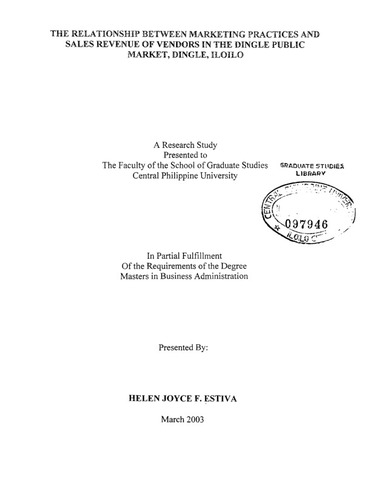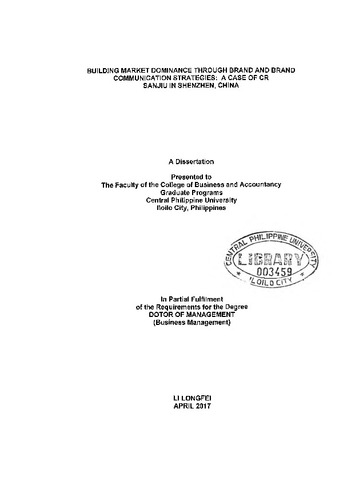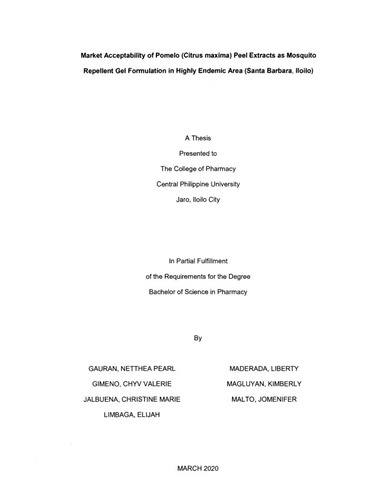| dc.description.abstract | Introduction
The Dingle Public Market is the center of commerce of Dingle, Iloilo. This public market has its regular market operations during the entire weeks of the year, which is from Monday to Sunday. During these days, the marketplace is crowded by different sorts of vendors coming from the different barrios of the town of Dingle. The usual customers of this marketplace are the residents of the town coming from the different barrios and if ever there are other buyers, these are very few buyers coming from the neighboring towns. The population of Dingle, as of 2002 coming from the Municipal Development Planning Office is estimated at around 36,000 residents. The market vendors during these regular market days are estimated at around 250 vendors, both regular and transient vendors, selling different type of goods, namely: fish, vegetables, meat and other dry goods both edible and non-edible. Based on observation, not all of the residents are regularly buying their goods from the Dingle Public Market and if they do their marketing, they would rather buy in the town of Pototan and Passi even though the market days are on weekdays, of which the former is during Tuesdays and Fridays of the month and the latter during Mondays and Fridays of the month. If the researcher has to look at it, these days would be very inconvenient considering that they have to get out of their workplaces just to go to the marketplaces of the neighboring towns of Dingle. Yet, as these regular residents go to neighboring towns simply to buy their goods, they say that: they can very much avail of savings as well as get a better quality of goods in the marketplaces of other towns, plus the fact that vendors are more accommodating in terms of bargaining (tawad system) in the neighboring towns’ marketplaces compared to that of their hometown’s public market. Considering the situation that the vendors in the Dingle Public Market are relatively making regular vending as their means of livelihood, the regular sales revenue that should have been realized from the residents who are having their marketing at these neighbor towns of Dingle, should have added to their own sales revenue and the taxes relative to these sales revenue, should have increased the taxes revenue of the municipality.
Why these residents have to go to other towns just to purchase their goods since these goods are available in the public market? These may be due to the marketing practices such as the pricing and “suki relationship” of these vendors in the Dingle Public Market. For these reason, the researcher has become interested on the topic: Marketing practices and its relation to sales revenue of vendors in Dingle Public Market. In addition to these, what are the typical Dingleanon marketing practices on vending? Do these marketing practices relatively vary as to their operations, procurement and product distribution as vendor in the public market? How significantly related are these marketing practices of vendors in the Dingle Public Market to the gross sales revenue they are realizing in every exchange taking place?
Statement of the Problem:
The purpose of this study is to determine the marketing practices and its relationship to gross sales revenue of vendors in the Dingle Public Market, Dingle, and Iloilo.
Specifically, it seeks to answer the following questions:
1. What are the demographic characteristics of vendors in terms of
a. Age
b. Gender
c. Civil Status
d. Educational Attainment?
2. What are the marketing practices of vendors in the Dingle Public Market in terms of:
a. Operations
b. Product Procurement
c. Product Distribution?
3. What is relationship between gross sales revenue and each of the following:
a. Operations
b. Product Procurement
c. Product Distribution?
Objectives:
This study will be conducted to determine the relationship between marketing practices and gross sales revenue of vendors in Dingle Public Market, Dingle, and Iloilo. The specific objectives of this study are:
1. To describe the vendors of Dingle Public Market, Dingle, and Iloilo according to age, gender, civil status, educational attainment?
2. To describe the marketing practices of vendors in terms of operations, product procurement, and product distribution.
3. To determine the relationship between gross sales revenue and the marketing practices of vendors in terms of operations, product procurement, and product distribution. | en_US |





